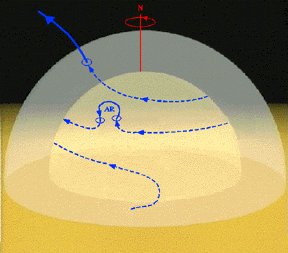
From the looping shape of fiery solar flares, to the varying intensity of the solar winds, to the mysterious 11-year sunspot cycle, large-scale events on the surface of the Sun are controlled by strong magnetic fields generated deep in its interior.
The location of the solar dynamo (below diagram and postscript version) where these fields originate has been something of a mystery. But now a team of Stanford scientists has narrowed the search for this region to a layer 38,000 miles thick and centered at a depth of about 135,000 miles below the solar surface. In this region, they have found evidence for two conditions indicative of the dynamo's presence: a high level of turbulence and shear flows caused by changes in rotation rate.
"Understanding the solar dynamo is extremely important to our overall understanding of the Sun's behavior. With these new data we can look forward to a rapid increase in our understanding of this key feature," said Philip H. Scherrer, the principal investigator of Stanford's Solar Oscillations Investigation team. Scherrer reported the new, more precise location of the dynamo layer at the American Geophysical Union meeting in San Francisco. He provided the information to fellow scientists in a poster paper and to the media in a news conference on Tuesday, Dec. 17, 1996.
The ability to track the solar dynamo's location with increased precision and to measure the conditions there with greater accuracy should allow the researchers to determine how the region changes during the solar cycle. Currently, the Sun is at its least active. As it moves into a more active phase the scientists should be able to determine whether the dynamo layer changes in location or thickness, and if it grows hotter or colder, Scherrer said.

The Stanford instrument, a Michelson Doppler Imager, measures the vertical motion of the Sun's photosphere simultaneously at a million different points and can detect surface movements as slow as a millimeter per second. Much of the Sun's surface motion is due to stationary "standing waves" created by sound waves that ricochet around the Sun's interior. These waves have periods ranging from about three to 20 minutes, considerably below the range of human hearing. Because the density of solar gases increases with depth, the waves are continually being refracted as they travel inward, forcing them to follow curving paths that bring them back to the surface where they are reflected downward again. As they do this repeatedly, they produce "standing waves" that cause different areas of the Sun's surface to vibrate in and out of phase in discernible patterns.
Shorter waves do not travel deeply, but the longer waves penetrate nearly to the Sun's center. So scientists can use them to obtain information about conditions within the Sun that otherwise are hidden beneath its fiery exterior. This is called helioseismology.
Helioseismology can provide information about temperatures and elemental composition in the Sun's interior because changes in these factors affect the speed with which pressure waves travel. For a similar reason, the technique also provides estimates of the how the rotation rate varies with depth. Such an analysis was the key to locating the position of the solar dynamo. In the 1970s solar physicists placed it in the convection zone, the outer 30 percent of the Sun where its gases boil much like water in a pot on the stove, forming giant cells of rising and falling gases that carry the heat to the surface. But in the early 1980s they realized that features could not persist long enough in this area to act as a dynamo. So attention shifted to the region just below the convection zone.
Ground-based helioseismic data, however, indicated that the shear layer in this region was fairly broad and overlapped significantly with the convection zone where the dynamo could not exist.
"This produced a lot of skepticism about the dynamo theory itself," reports Alexander Kosovichev, a senior research scientist in SOI who did much of the current analysis. It even led some scientists to propose that the Sun's magnetic field might be locked in its core, he says.
Four months of SOHO observations have resolved this apparent problem. They show that the shear layer is sharper and does not extend into the convection zone as suggested by ground-based measurements. Also, they indicate that sound waves speed up more than expected in this region (below diagram and postscript version), indicating that the turbulence and mixing associated with a dynamo are present.

At this distance,
which is about two-thirds of the way from the Sun's center to its surface, the
Sun undergoes a fundamental change in the nature of its rotation. Inside this
boundary the Sun rotates like a solid object. Closer to the surface the
rotation rates at different latitudes begin to diverge, with the equatorial
regions rotating more rapidly than the middle latitudes and polar regions.